Trending
Opinion: How will Project 2025 impact game developers?
The Heritage Foundation's manifesto for the possible next administration could do great harm to many, including large portions of the game development community.

Featured Blog | This community-written post highlights the best of what the game industry has to offer. Read more like it on the Game Developer Blogs or learn how to Submit Your Own Blog Post
This article explores the power of Polytonality in the game music of Jurassic World Primal Ops (from Winifred Phillips’ highly-rated GDC 2023 lecture, “Chaos Theory in Game Music.”)

By Winifred Phillips | Contact | Follow
Hello there! I’m video game composer Winifred Phillips. Welcome to the fourth article in my series based on my GDC 2023 lecture, “Chaos Theory: The Music of Jurassic World Primal Ops.” Before we continue with the article series, I’d like to share some related news – the Academy of Interactive & Visual Arts just awarded my music for Jurassic World Primal Ops with a 2023 Gold in the W3 Awards! This is the 18th year that the AIVA has recognized “heroes of digital creativity,” and I’m thrilled that my music for this project was recognized by the AIVA!
.webp?width=700&auto=webp&quality=80&disable=upscale)
So happy to be discussing my Jurassic World Primal Ops music in this ongoing article series! In these articles, I’ve included the substance of my GDC lecture, augmented with the videos, audio files, and some of the illustrations from the visual presentation that accompanied my lecture.
During the first three articles, we considered the world-famous Jurassic Park / Jurassic World franchise, and the release of the Jurassic World Primal Ops video game in concert with the theatrical run of the latest movie, Jurassic World Dominion. I shared what it was like composing new music for a game in this famous and immensely popular franchise. By creating a musical score that emphasized unpredictability and chaos, I was able to enhance the tension and anxiety of playing an action-driven game featuring bloodthirsty dinosaurs on the loose in the modern world.
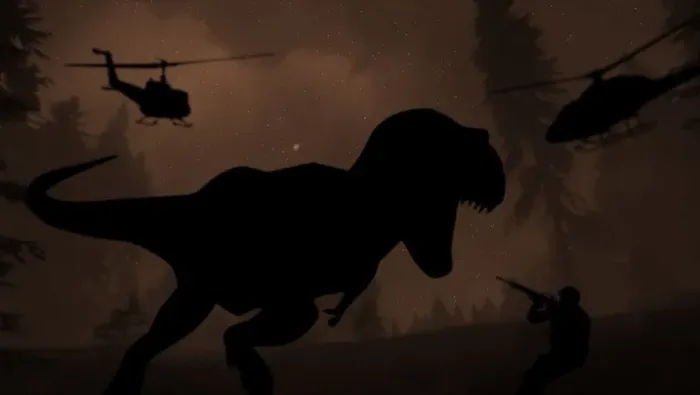
You’ll find all these ideas discussed in detail in these three articles:
Part One: Tonic Pivot (The Music of Jurassic World Primal Ops: GDC 2023)
Part Two: Quartal Chords and Chromatics (The Music of Jurassic World Primal Ops: GDC 2023)
Part Three: Whole Tone and Octatonic Scales (The Music of Jurassic World Primal Ops: GDC 2023)
We’d just finished discussing the fantastic utility of both the Octatonic and Whole Tone scales, which are particularly useful when we’re pushing our music away from a classic harmonic structure and towards atonality. But now let’s take a moment to step away from atonality altogether, and consider its close cousin – polytonality.
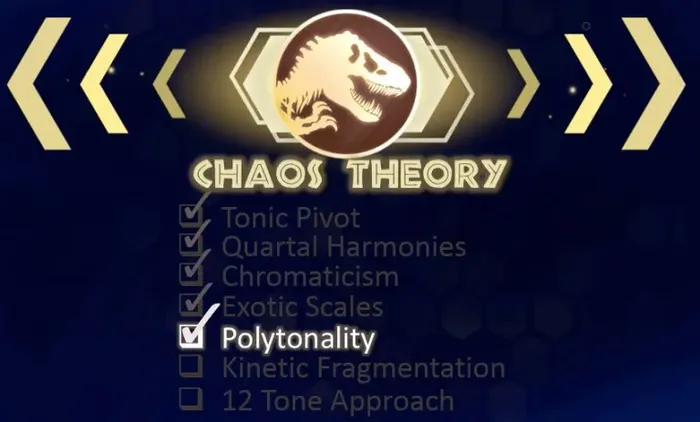
We’re all very familiar with traditional key signatures. In classic music theory, key signatures control what chords we hear, what harmonic progressions may occur, and how melodies might take shape. When we go fully atonal, we distance ourselves from these rules – but with polytonality, we keep using them – albeit in a devious way.
Instead of hiding the tonal center, we construct our music to assert more than one at a time.
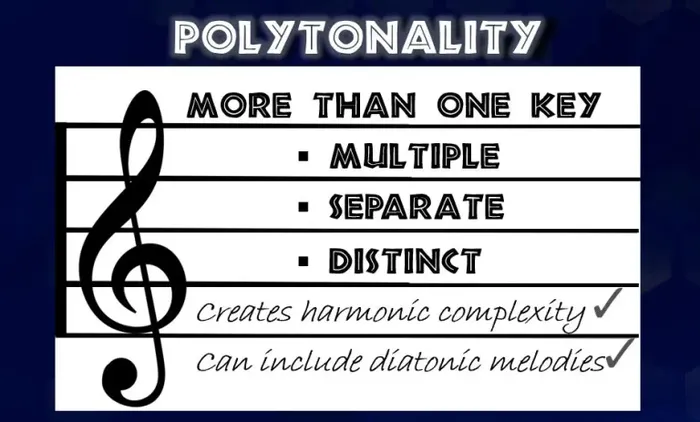
When listening to a track expertly structured in this way, we can sense multiple separate and distinct key signatures happening simultaneously, and this is great at creating some really interesting harmonic complexity. Best of all, the music can include classically-diatonic melodies on top – and still feel conspicuously weird, due to all the unrelated chord structures going on underneath.
I want to share some musical examples of polytonality now – with the caveat that this stuff can get pretty complicated. I’ll be going through a bunch of details here, but mostly to give you a general feel for how polytonality works. Let’s start by checking out a relatively simple example.
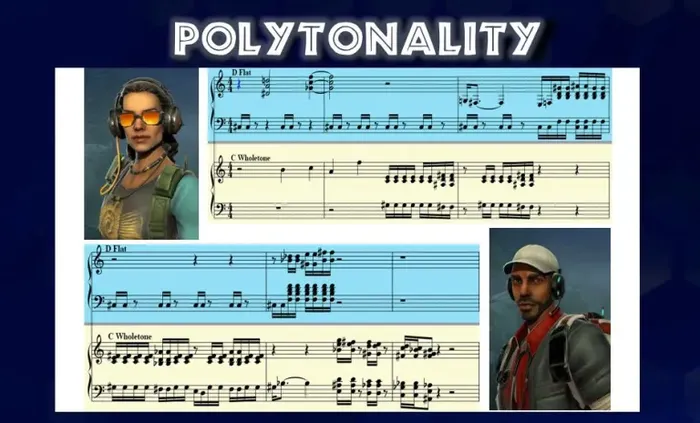
This is another piece of music that accompanies ‘tracking’ sequences when players are searching for wild dinosaurs. I built the music around the whole tone scale – we already discussed how this scale works in the music of Jurassic World Primal Ops. For this particular composition, I put the initial chord structure into the C wholetone scale.
Winifred Phillips · The C Wholetone Scale
But the bassline is assertively hitting D flat as the root tone:
Winifred Phillips · The D Flat Root Tone
And D flat is not at all in the C wholetone scale. Plus, half of the foreground melody is written with a D flat major feel:
Winifred Phillips · The D Flat Major Scale
Then, the other half of the foreground melody follows the C wholetone scale:
Winifred Phillips · The C Wholetone Scale
The chords support the melody by swinging back and forth between D flat major and C wholetone – making the entire thing feel bizarrely unstable. Let’s check that out now – you’ll see that I’ve included some of the notation on-screen, with the D flat major and C wholetone content divided into different staves so we can track what’s happening:
Now I want to share with you a more complex example of polytonality in the music I composed for Primal Ops. We’re going to be listening to this music, but I’ll break it down for you first.
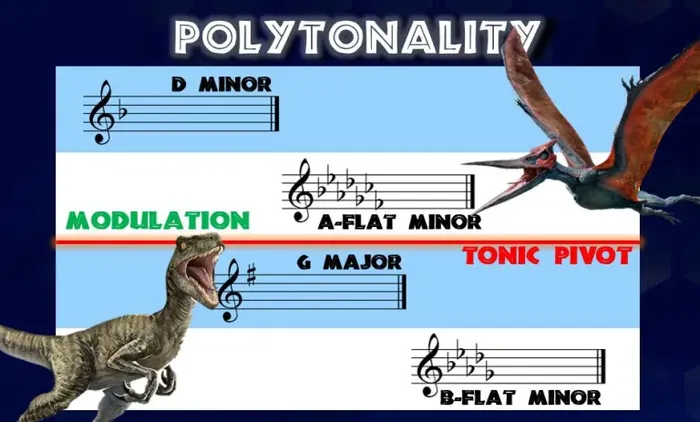
The orchestra begins with a repeating diminished 7th chord in D minor. The string section gives us some nervous figures in A flat minor. So – two simultaneous unrelated keys:
D minor:
Winifred Phillips · The Key of D Minor
A flat minor:
Winifred Phillips · The Key of A Flat Minor
After that, we modulate into a hard tonic pivot, which takes the background chords and the agitated string section into 7th chords in G major:
Winifred Phillips · The Key of G Major
While that’s happening, the melody and bass line move to B flat minor:
Winifred Phillips · The Key of B Flat Minor
So, there’s lots of polytonality! We’ll get a better sense of it when we’re listening to the music. As before, I’ve divided the different key signature content so we can follow along, and you’ll see that I’ve indicated where the modulation and the tonic pivot happen:
Polytonality is an uncommon harmonic device, just like the tonic pivots, quartal harmonies, Chromaticism, and exotic scales that we’ve discussed so far during this talk. All these techniques help us to break away from harmonic conventionalism. But harmony is just a piece of the puzzle, and it certainly isn’t the only way we can introduce chaos into our game scores.
In the next article of this series, we’ll be shifting our discussion away from harmonies, and talking about kinetics. In the meantime, you can read more about game music composition in my book, A Composer’s Guide to Game Music. Thanks for reading!
.webp?width=700&auto=webp&quality=80&disable=upscale)

Winifred Phillips is a BAFTA-nominated video game composer. The music she composed for her latest video game project Jurassic World Primal Ops won both the Global Music Award and the NYX Award, and was nominated for a Society of Composers & Lyricists Award for Outstanding Score for Interactive Media, and a Game Audio Network Guild Award in the category of Music of the Year. Other recent releases include the hit PlayStation 5 launch title Sackboy: A Big Adventure (soundtrack album now available). Popular music from Phillips’ award-winning Assassin’s Creed Liberation score was featured in the performance repertoire of the Assassin’s Creed Symphony World Tour, which made its Paris debut with an 80-piece orchestra and choir. As an accomplished video game composer, Phillips is best known for composing music for games in many of the most famous and popular franchises in gaming: the list includes Assassin’s Creed, God of War, Total War, The Sims, and Sackboy / LittleBigPlanet. Phillips’ has received numerous awards, including an Interactive Achievement Award / D.I.C.E. Award from the Academy of Interactive Arts and Sciences, six Game Audio Network Guild Awards (including Music of the Year), and four Hollywood Music in Media Awards. She is the author of the award-winning bestseller A COMPOSER’S GUIDE TO GAME MUSIC, published by the MIT Press. As one of the foremost authorities on music for interactive entertainment, Winifred Phillips has given lectures at the Library of Congress in Washington DC, the Society of Composers and Lyricists, the Game Developers Conference, the Audio Engineering Society, and many more. Phillips’ enthusiastic fans showered her with questions during a Reddit Ask-Me-Anything session that went viral, hit the Reddit front page, received 14.9 thousand upvotes, and became one of the most popular gaming AMAs ever hosted on Reddit. An interview with her has been published as a part of the Routledge text, Women’s Music for the Screen: Diverse Narratives in Sound, which collects the viewpoints of the most esteemed female composers in film, television, and games. Follow her on Twitter, Facebook, Instagram, and Threads.
You May Also Like